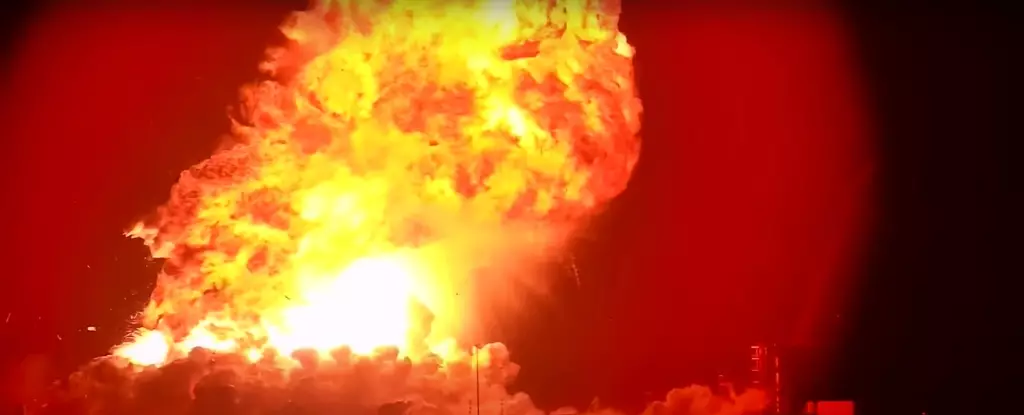In a startling display of ambition meeting reality, SpaceX’s recent ground test explosion underscores a pivotal moment in Elon Musk’s quest to establish a human presence on Mars. Late in the evening on Wednesday, a routine static fire test at the Starbase facility in Texas transformed into a catastrophic event when a pressurized tank failed, unleashing a fireball that would dominate the night sky. For a company known for daring feats and breakthrough technology, incidents like this illuminate the complex and often perilous nature of cutting-edge aerospace innovation.
The explosion’s aftermath did not result in physical injuries, thanks largely to the safety protocols that included establishing a no-go zone around the test site. However, the event raises critical questions about the implications of hurried development within the aerospace sector. Musk’s nonchalant attitude—referring to the destruction as “just a scratch”—is emblematic of a culture that often prioritizes rapid advancement over thorough risk assessment. It’s a mantra of “fail fast, learn fast,” but there’s an unsettling impression that safety may be taking a back seat to ambition.
The Cost of Innovation
SpaceX’s approach might be seen as a double-edged sword. On the one hand, the company’s iterative design and testing process allows for swift improvements that can outpace traditional aerospace methodologies. Yet, this experimental ethos carries inherent risks. Each explosion, each spectacular failure, creates not only physical damage but also a potential erosion of public confidence in the vision Musk espouses. The Starship, which stands as a marvel of engineering, boasts an impressive capacity and operational efficiency—up to 150 metric tons, after all—but such claims must be matched by tangible reliability.
The extensive history of explosions and failures during test flights raises eyebrows, especially as Musk and SpaceX herald their intentions of a manned journey to Mars by the mid-2020s. Thus far, catastrophic failures have plagued the Starship’s test flights, culminating in a disastrous prototype explosion over the Indian Ocean just months prior. While resilience in the face of adversity is admirable, it is equally critical to consider whether the relentless drive for success might lead to complacency when it comes to assessing genuine risks.
Environmental Considerations and NASA’s Leaning
Furthermore, the implications of expanded testing on the environment have not escaped scrutiny. The Federal Aviation Administration’s decision to increase annual Starship launches from five to twenty-five occurs against the backdrop of widespread environmental concern. Conservation groups have vehemently objected, highlighting threats posed to local ecosystems, particularly to endangered species such as sea turtles and shorebirds. Musk’s vision faces opposition not merely from competitors, but from a broader societal dialogue about the environmental repercussions of technological advancement.
SpaceX’s role in NASA’s operations highlights another layer to this narrative. As the agency increasingly relies on SpaceX for ferrying astronauts to the International Space Station, it finds itself intertwined in the intricate web of rapid innovation and environmental accountability. The assumption that commercial endeavors and public funding can coexist harmoniously is increasingly challenged by real-world consequences, making it essential for both parties to adopt a more sustainable approach.
Ambition: A Two-Edged Sword
Ultimately, while Musk’s audacious dreams ignite imaginations, they must be grounded in a cautious understanding of the underlying realities of space exploration. Innovating in the name of exploration requires responsibility that extends beyond mere technological advancement. The public must not only share in the excitement of discovering new frontiers but also hold the stewards of these endeavors accountable for the environmental and social ramifications of their actions.
SpaceX’s saga thus serves as a compelling warning: ambition, while necessary, should not overshadow the paramount importance of safety, sustainability, and community impact. Musk’s dreams of cosmic expansion could very well redefine humanity’s place in the universe, but that dream must not come to fruition at the expense of our planet and its myriad inhabitants. In an era of unprecedented technological potential, true progress will invariably hinge on harmonizing aspirations with ethical practicality.

Leave a Reply